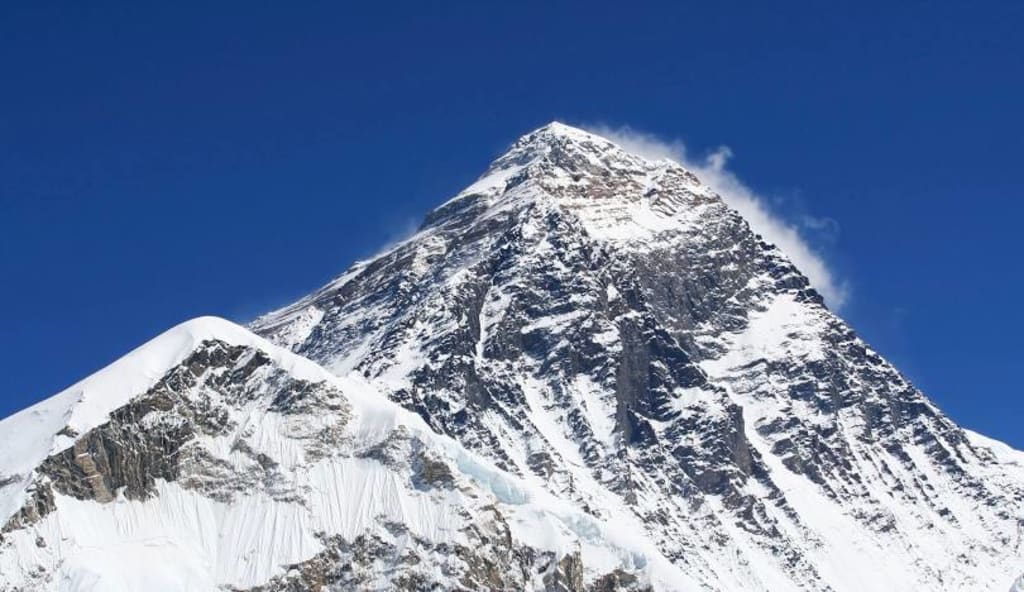FULL STORY ABOUT MOUNT EVEREST
A CAPTURE OF HAT MOUNT EVEREST IS

Mount Everest, also known as Sagarmatha in Nepal and Chomolungma in Tibet, is the world's highest mountain, with a peak reaching 29,032 feet (8,849 meters) above sea level. It is located in the Himalayas on the border between Nepal and the Tibet Autonomous Region of China.
The first recorded attempts to reach the summit of Mount Everest were made in the early 1920s, and the mountain has since become a symbol of both human endurance and the challenges of extreme altitude mountaineering. The first successful ascent to the summit of Mount Everest was achieved on May 29, 1953, by Sir Edmund Hillary of New Zealand and Tenzing Norgay, a Sherpa of Nepal, as part of a British expedition led by Colonel John Hunt.
Since then, Mount Everest has continued to draw climbers from around the world, and it remains a coveted and challenging goal for mountaineers. The mountain presents numerous dangers, including extreme weather conditions, avalanches, crevasses, and the notorious "death zone" above 26,000 feet, where the human body's ability to acclimatize is severely compromised due to the low levels of oxygen.
Over the years, Mount Everest has seen both triumphs and tragedies, with stories of heroic achievements and heartbreaking losses. The mountain has also been the subject of environmental concerns, as the increasing number of climbers has led to issues such as overcrowding, litter, and the impact of human activity on the fragile ecosystem of the mountain.
Despite the challenges and risks, Mount Everest continues to captivate the imagination of adventurers and explorers, and its allure as the world's highest peak remains undiminished.
Mount Everest is a remote and challenging mountain, and most people who visit the area do so with the goal of climbing to the summit. However, there are still some stunning places to visit in the region if you are not a mountaineer. Here are a few:
1. Everest Base Camp: This is the starting point for most climbers attempting to reach the summit of Mount Everest. The base camp is located at an altitude of 17,598 feet (5,364 meters) and offers stunning views of the mountain.
2. Kala Patthar: This is a small peak located near Everest Base Camp that offers incredible views of Mount Everest and the surrounding peaks. Kala Patthar is also a popular spot for trekkers who are not attempting to climb the mountain.
3. Gokyo Lakes: This is a series of turquoise lakes located in the Gokyo Valley, which is a popular trekking destination in the Everest region. The lakes are surrounded by snow-capped peaks and offer some of the most beautiful scenery in the area.
4. Khumbu Glacier: This is the largest glacier in the Everest region and is a popular destination for trekkers. The glacier is located at an altitude of over 16,000 feet (4,877 meters) and offers stunning views of the surrounding mountains.
5. Namche Bazaar: This is a small town located at an altitude of 11,286 feet (3,440 meters) and is the gateway to the Everest region. Namche Bazaar is a popular stop for trekkers and offers a range of amenities, including restaurants, shops, and lodges.
The time it takes to climb Mount Everest can vary significantly depending on a variety of factors, including the route chosen, weather conditions, acclimatization needs, and individual fitness levels. Typically, a full expedition to climb Mount Everest can take around two months, including time for acclimatization, rest periods, and waiting for a suitable weather window to make the final push to the summit.
The ascent itself from the base camp to the summit can take several days. Climbers will typically establish a series of high camps at increasingly higher altitudes, gradually ascending and descending to aid in acclimatization. The final push from the highest camp to the summit and back can take anywhere from 12 to 20 hours, depending on the climber's pace and the conditions.
It's important to note that climbing Mount Everest is an extremely demanding and dangerous endeavor, and climbers must be prepared for the physical and mental challenges, as well as the risks associated with high-altitude mountaineering. Additionally, many climbers spend years preparing for such an expedition, including building up their climbing experience on other high-altitude peaks and undergoing rigorous physical training.





Comments
There are no comments for this story
Be the first to respond and start the conversation.